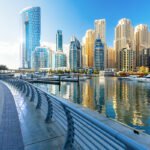Now Reading: Dubai Real Estate: 6 Benefits of Investing in No-Tax Districts
-
01
Dubai Real Estate: 6 Benefits of Investing in No-Tax Districts
Dubai Real Estate: 6 Benefits of Investing in No-Tax Districts

Table of Contents
Dubai’s real estate market is a global magnet for investors, particularly from the U.S., due to its tax-free environment and high rental yields. With no personal income tax, capital gains tax, or annual property taxes, investors retain 100% of rental income and resale profits, unlike U.S.
markets where taxes can reduce returns by 15-30%. The UAE dirham’s peg to the U.S. dollar eliminates currency risk, and the Golden Visa, offering 10-year residency for investments of AED 2 million ($545,000), enhances appeal.
In 2025, Dubai’s market is booming, with Q1 transactions reaching AED 110 billion and a 19.9% price increase, per Dubai Land Department data. This article explores six key benefits of investing in Dubai’s no-tax freehold districts, empowering U.S. investors to maximize returns in 2025.
1. Full Retention of Rental Income
Dubai’s no-tax districts, such as Downtown Dubai and Dubai Marina, allow investors to keep 100% of rental income without income tax deductions. A $1 million apartment in Dubai Marina yielding 7% generates $70,000 annually, tax-free, compared to $49,000-$56,000 after U.S. federal (up to 37%) and state taxes (e.g., 13.3% in California).
High-yield zones like Jumeirah Village Circle (JVC) (7-8%) and Business Bay (6-7%) ensure strong cash flow. U.S. investors must report rental income on IRS Schedule E (Form 1040), but deductions like depreciation ($36,364 annually for a $1 million property) can offset taxable income.
2. Zero Capital Gains Tax on Resale Profits
Unlike the U.S., where long-term capital gains taxes reach 15-20% (plus state taxes), Dubai’s no-tax districts impose no capital gains tax, allowing investors to retain full resale profits. For example, a $2 million property in Palm Jumeirah purchased in 2025 could appreciate to $2.4 million by 2030, yielding a $400,000 tax-free gain.
Freehold zones like Dubai Creek Harbour and Dubai South offer 7-10% annual appreciation, particularly for off-plan projects like Emaar’s Creek Crescent. This tax advantage boosts ROI compared to markets like London, with its 28% capital gains tax for non-residents.
3. No Annual Property Taxes
Real Estate, Dubai’s no-tax districts, including Emirates Hills and Bluewaters Island, have no annual property taxes, unlike U.S. markets where taxes average 1-2% of property value. For a $3 million villa in Emirates Hills, this saves $30,000-$60,000 annually compared to cities like New York or Los Angeles.
These savings can be reinvested into additional properties or maintenance, enhancing long-term returns. High-yield zones like Dubai South (up to 8.1%) benefit from this cost efficiency, making holding properties more profitable.
4. Zero-Rated VAT on First Residential Sales
Under UAE’s Federal Decree-Law No. 8 of 2017, the first sale of residential properties in no-tax districts within three years of completion is zero-rated for VAT, enabling developers to recover input VAT without charging buyers. In 2025, stricter compliance requires completion certificates within 30 days, ensuring projects like Azizi Riviera in Mohammed Bin Rashid City (MBR City) (starting at AED 600,000, $163,000) remain VAT-free. Long-term leases (over six months) are VAT-exempt, reducing costs compared to U.S. markets with 5-8% transaction taxes.
5. Golden Visa Residency Benefits
Investing AED 2 million ($545,000) in no-tax freehold districts like Downtown Dubai or Palm Jumeirah qualifies investors for the Golden Visa, with 2025 updates lowering the threshold to AED 1.5 million ($408,000) for off-plan properties in zones like Dubai South. This 10-year residency reduces travel and management costs, indirectly boosting tax efficiency. For example, a $1.5 million apartment in Dubai Creek Harbour yielding 7% generates $105,000 tax-free annually, with residency simplifying operations. U.S. investors must report assets over $50,000 (single filers) via Form 8938.
6. Currency Stability and High Yields
The UAE dirham’s peg to the U.S. dollar ensures no currency risk, protecting returns in no-tax districts like Business Bay and JVC, where yields range from 6-8%. For instance, a $500,000 apartment in JVC yielding 8% generates $40,000 tax-free annually, with stable value compared to markets like London, where currency fluctuations add risk. Dubai’s 25 million projected tourists in 2025 drive 85%+ occupancy rates in tourism-heavy zones like Dubai Marina. Off-plan projects offer 7-10% appreciation, enhancing returns.
U.S. Tax Compliance Considerations
Dubai’s no-tax districts deliver superior returns compared to U.S. cities like New York (2-4% yields). A $1 million property yielding 7% generates $70,000 tax-free annually, versus $50,000-$60,000 after U.S. taxes. U.S. investors must report rental income on Schedule E, deducting expenses like depreciation, maintenance, and management fees. Foreign assets over $50,000 (single filers) or $100,000 (joint filers) require Form 8938, and accounts exceeding $10,000 need an FBAR. Non-compliance risks penalties up to $100,000. The 4% DLD transfer fee isn’t creditable against U.S. taxes. Consult a tax professional to optimize deductions.
Risks and Mitigation Strategies
Dubai’s market is robust, with AED 306.3 billion in 2024 transactions and a projected 5-9% price increase in 2025. Risks include off-plan delays in Dubai South or MBR City, oversupply in JVC, and global economic factors like oil price volatility. Mitigate by choosing developers like Emaar or Azizi, verifying escrow compliance with DLD, and diversifying across zones like Downtown Dubai and Dubai Marina.
Why Dubai in 2025?
Dubai’s Economic Agenda D33, aiming to double the economy by 2033, and 25 million projected tourists in 2025 fuel demand in no-tax districts. Yields of 6-10%, zero taxes, and Golden Visa benefits outpace global hubs like London (3-5%) or Singapore (3-5%). These six benefits full rental income retention, zero capital gains tax, no property taxes, zero-rated VAT, Golden Visa advantages, and currency stability make no-tax districts like Downtown Dubai, Dubai Marina, and Dubai South prime investment choices for U.S. investors in 2025.
In conclusion, Dubai’s no-tax districts offer unmatched opportunities for U.S. investors. By leveraging these tax benefits, partnering with reputable developers, and ensuring IRS compliance, investors can maximize wealth in one of the world’s most dynamic real estate markets. Real Estate
read more: Dubai Tax Guide: 5 Property Types With Reduced Legal Costs






















